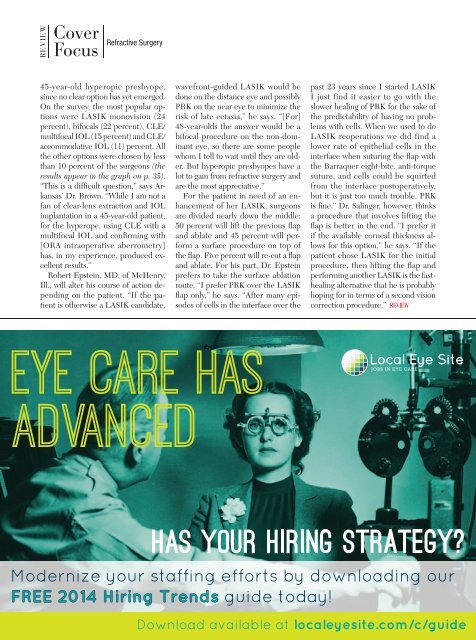dhjBa
dhjBa
dhjBa
You also want an ePaper? Increase the reach of your titles
YUMPU automatically turns print PDFs into web optimized ePapers that Google loves.
REVIEW<br />
Cover<br />
Focus<br />
Refractive Surgery<br />
45-year-old hyperopic presbyope,<br />
since no clear option has yet emerged.<br />
On the survey, the most popular options<br />
were LASIK monovision (24<br />
percent), bifocals (22 percent), CLE/<br />
multifocal IOL (15 percent) and CLE/<br />
accommodative IOL (11) percent. All<br />
the other options were chosen by less<br />
than 10 percent of the surgeons (the<br />
results appear in the graph on p. 35).<br />
“This is a difficult question,” says Arkansas’<br />
Dr. Brown. “While I am not a<br />
fan of clear-lens extraction and IOL<br />
implantation in a 45-year-old patient,<br />
for the hyperope, using CLE with a<br />
multifocal IOL and confirming with<br />
[ORA intraoperative aberrometry]<br />
has, in my experience, produced excellent<br />
results.”<br />
Robert Epstein, MD, of McHenry,<br />
Ill., will alter his course of action depending<br />
on the patient. “If the patient<br />
is otherwise a LASIK candidate,<br />
wavefront-guided LASIK would be<br />
done on the distance eye and possibly<br />
PRK on the near eye to minimize the<br />
risk of late ectasia,” he says. “[For]<br />
48-year-olds the answer would be a<br />
bifocal procedure on the non-dominant<br />
eye, so there are some people<br />
whom I tell to wait until they are older.<br />
But hyperopic presbyopes have a<br />
lot to gain from refractive surgery and<br />
are the most appreciative.”<br />
For the patient in need of an enhancement<br />
of her LASIK, surgeons<br />
are divided nearly down the middle:<br />
50 percent will lift the previous flap<br />
and ablate and 45 percent will perform<br />
a surface procedure on top of<br />
the flap. Five percent will re-cut a flap<br />
and ablate. For his part, Dr. Epstein<br />
prefers to take the surface ablation<br />
route. “I prefer PRK over the LASIK<br />
flap only,” he says. “After many episodes<br />
of cells in the interface over the<br />
past 23 years since I started LASIK<br />
I just find it easier to go with the<br />
slower healing of PRK for the sake of<br />
the predictability of having no problems<br />
with cells. When we used to do<br />
LASIK reoperations we did find a<br />
lower rate of epithelial cells in the<br />
interface when suturing the flap with<br />
the Barraquer eight-bite, anti-torque<br />
suture, and cells could be squirted<br />
from the interface postoperatively,<br />
but it is just too much trouble. PRK<br />
is fine.” Dr. Salinger, however, thinks<br />
a procedure that involves lifting the<br />
flap is better in the end. “I prefer it<br />
if the available corneal thickness allows<br />
for this option,” he says. “If the<br />
patient chose LASIK for the initial<br />
procedure, then lifting the flap and<br />
performing another LASIK is the fasthealing<br />
alternative that he is probably<br />
hoping for in terms of a second vision<br />
correction procedure.”


